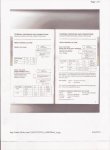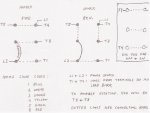jetlag
Senior Member
- Location
- Eatonton, Georgia
I am trying to install a reversing control on a boat hoist. The control has up and down momentary buttons. The motor label shows to reverse the motor swap the blue and yellow wires on the motor push on connectors. I used 14/4 wire to send the blue and yellow wire down and depending on which button is used the control sends it back reversed or not reversed polarity to the terminals. Ok all is fine except when a button is not being used the motor hums . I didnt think current went to the motor if the blue and yellow leads were open, it seems now they only go to the start winding and the motor is trying to start on the run windings. The 120 volt is coming in on L1 and L2. to the motor. The switches on here before were not safe because the reversing switch didnt have off position it stayed on up or down and a seperate snap switch turned the power on , and the winch kept running until the snap switch was turned off. If I leave the snap switch there someone will burn they motor if the dont use the buttons right away. Does some one know if this is not a true reversible motor . I didnt think the reversing switch had to control the line in also ?



